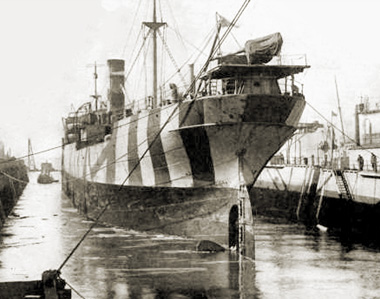Sunday, October 28, 2012
Camouflage Artist | Frederick J. Hoertz
Above These news photographs of unidentified American dazzle-camouflaged ships were published in The Morse Drydock Dial (April 1919), p. 4. They accompanied an article by C. Stewart Wark titled "Why Camouflage?" Here are a couple of excerpts—
We all remember the first camouflaged ship that came into the dry dock. How grotesque it looked and what a strange sight it was to our eyes. Then the number of them began to increase with such amazing rapidity that the sight no longer had any charms, and we began to regard the zigzag and whatnot painting designs without any particular regard.
Later in the article, Wark talks about having seen the camouflage of an American troopship the USS Von Steuben, which bore a dazzle camouflage scheme on its starboard side, while on its port side was painted a ship silhouette, making it seem escorted by a destroyer. It is highly probable, the article continues—
that this idea originated with Mr. [Frederick J.] Hoertz [1889-1978], the artist who drew the cover for this issue of The Dial. Mr. Hoertz submitted designs to the government which were exactly duplicated on the Von Steuben. His idea also called for smoke pots just over the dummy funnels to make the painted destroyer seem more realistic.
This idea of deception in regard to the character of the craft was used more extensively and to better effect by the Italians than by the naval authorities of our country, where that system could not be said to have gotten above the experimental stage.
A favorite effect employed by the Italian navy was to camouflage a ship so that from a distance it looked like two or three vessels, all heading in different directions. The Italian battleships at our docks some time ago showed that method of camouflaging.

